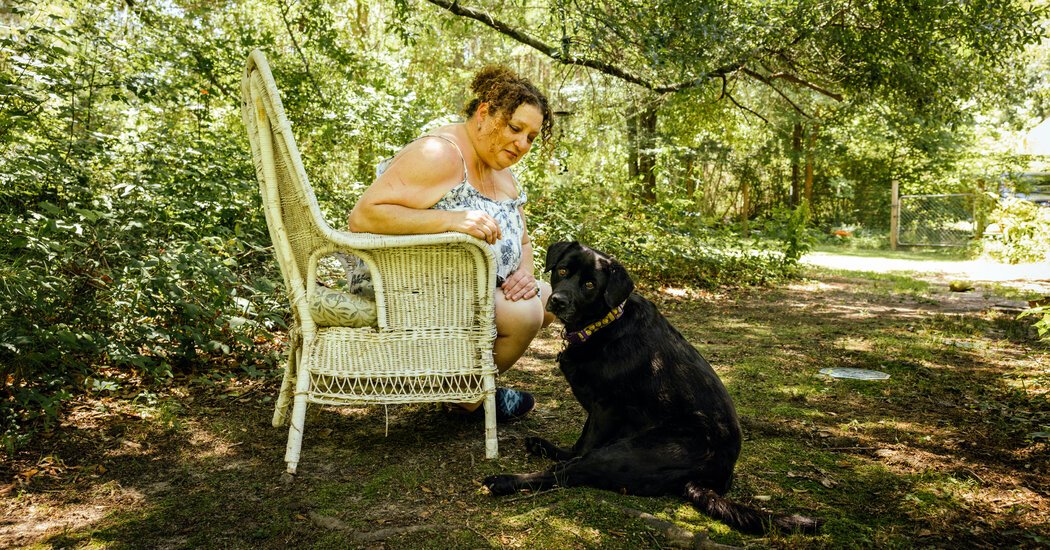Heather Massey introduced Ladybird to the veterinarian when the 9-year-old mutt started having seizures. A scan from an M.R.I. machine revealed dangerous information: mind most cancers.
With the prognosis grim, Ms. Massey determined in opposition to additional remedy on the animal hospital close to her dwelling in Athens, Ga., and Ladybird died 4 months later. The M.R.I. scan and associated care had price practically $2,000, which Ms. Massey placed on a specialty bank card she had realized about at a earlier vet go to.
That was in 2018. She remains to be paying off the debt, with greater than 30 % curiosity.
“Could I afford to try this? Not actually,” mentioned Ms. Massey, 52, who’s disabled and doesn’t work. “Was it price it to me? Yes.”
Ms. Massey’s expertise illustrates the costly new realities of proudly owning a pet. For a long time, veterinarians usually operated their very own clinics, shepherding generations of pets from delivery to loss of life. They neutered, vaccinated and pulled thorns from paws and noses. When animals turned severely unwell, vets usually had little to supply past condolences and a humane loss of life.
But in recent times, as individuals have grown extra connected to their pets — and more willing to spend cash on them — animal medication has reworked into an enormous enterprise that appears rather a lot like its human counterpart. Many veterinary places of work have been changed by hospitals outfitted with costly M.R.I. machines, refined lab gear and round the clock intensive care items. Dogs and cats usually see extremely skilled specialists in neurology, cardiology and oncology.
This high-tech care has spurred a booming market. Veterinary costs have soared greater than 60 % over the previous decade, in response to federal statistics. Private fairness corporations and enormous companies have bought a whole lot of services across the nation, an acquisition spree paying homage to the company roll-ups of docs’ places of work.
Veterinarians from across the nation informed The New York Times that their company managers had been pushing clinics to turn into extra environment friendly revenue facilities. Vets had been usually paid primarily based on how a lot cash they introduced in, creating an incentive to see extra pets, order extra assessments and upsell wellness plans and meals.
The result’s an more and more unsustainable state of affairs for animal house owners, most of whom don’t have pet insurance coverage.
The Times requested readers to share their tales about costly vet payments, and a whole lot responded. Sophia McElroy of Denver mentioned she donated blood plasma and took additional freelance work to pay for her canine’s ongoing bills.
Nancy Partridge of Waynesville, N.C., mentioned that months after her cat was recognized with an inoperable tumor, she was nonetheless chipping away on the $1,500 invoice. “We have a lifeless cat, and we’re nonetheless paying,” she mentioned.
In 2015, Claire Kirsch was incomes lower than $10 an hour as a veterinary technician in Georgia when her personal canine, Roscoe, and her horse, Gambit, every had medical emergencies, leading to payments that totaled greater than $13,000. Ms. Kirsch mentioned her animals would have died had she not opted for extra care.
“I knew I’d by no means be capable to forgive myself if we didn’t attempt,” she mentioned.
Ms. Kirsch maxed out a bank card, tapped into her husband’s retirement account and took out a private mortgage. Roscoe lived one other three years, and Gambit remains to be alive.
In interviews, veterinarians mentioned pet house owners who complained about care prices don’t respect the difficulties of operating a clinic. Veterinarians make far much less cash than human doctors and are sometimes in debt from years of training. Their costs have gone up partly due to the rising price of medication, vaccines and different provides, in addition to paying staff in a decent labor market.
And due to extra superior medical choices, pets immediately can survive critical diseases, like most cancers, that may as soon as have been unthinkable. They have entry to surgical procedures and medicines that may vastly enhance their lives.
“We stay in essentially the most technologically superior time in human historical past, and the way fantastic is that?” mentioned Dr. Tracy Dewhirst, a veterinarian in Corryton, Tenn. “But it comes at a price.”
Even run-of-the-mill visits can rack up large payments. Dr. David Roos, an 86-year-old veterinarian in Los Altos, Calif., mentioned he determined to retire sooner or later in 2014, when he checked on a canine whose house owners had been longtime shoppers. The animal had been admitted for vomiting. Dr. Roos mentioned he usually would have informed the proprietor to take the canine dwelling and to provide it sips of water. Instead, one other vet had ordered X-rays, blood assessments, intravenous fluids and a hospital keep. Dr. Roos knew the house owners couldn’t afford the invoice.
“I noticed at that stage that veterinary medication had modified to the purpose the place I not wished to be part of it,” Dr. Roos mentioned.
With a growth in pet ownership and surveys showing that Americans are prepared to enter debt to pay for his or her animals’ care, vet clinics have turn into more and more engaging to buyers. About one-quarter of main care clinics and three-quarters of specialty clinics at the moment are owned by companies, in response to Brakke Consulting, which focuses on the animal well being trade.
In 2015, one main participant, Mars — recognized for selling candy and pet meals — acquired a specialty veterinary hospital chain, BluePearl, for an undisclosed sum. In 2017, it nabbed one other hospital, VCA, for $9.1 billion. The pattern peaked in 2021, with greater than 200 non-public fairness offers, according to Pitchbook.
Several veterinarians who’ve labored in company practices mentioned that they had been pressured to drive extra enterprise. One vet from California mentioned she give up her job after she was informed her “price per consumer” was too low. Another, from Virginia, mentioned she was informed she wanted to see 21 animals per day. A 3rd, from Colorado, mentioned she was stunned when she overheard a supervisor saying among the vets at her workplace wanted teaching on “getting the consumer to a sure.” These vets requested to withhold their names as a result of they frightened that talking out might jeopardize future job prospects with private-equity practices.
Other vets mentioned that company possession had no affect on the care they supplied. Still, Dr. Andrew Federer, the medical director of a clinic in Mentor, Ohio, that’s owned by a sequence referred to as National Veterinary Associates, mentioned that when somebody’s pay is tied to what number of procedures and assessments they carry out, the incentives might be tough to disregard, particularly for vets who had been simply beginning out.
“The extra they convey into the hospital above their present wage, the extra of a manufacturing bonus they’ll obtain,” he mentioned.
Only about 4 percent of pet owners have insurance coverage, and even for them, the choices are restricted. Pet insurance coverage usually excludes pre-existing circumstances and prices extra for older pets who usually tend to get sick.
Companies can even change the phrases. This spring, the insurance coverage firm Nationwide notified hundreds of pet house owners that it was discontinuing their protection, leaving them scrambling to enroll in new plans that excluded the pets’ pre-existing circumstances. About 100,000 plans are being discontinued, mentioned Kevin Kemper, a Nationwide spokesman.
Stephanie Boerger of Royal Oak, Mich., mentioned that Nationwide had been protecting her cat’s chemotherapy, however informed her it could not renew her plan when it expired in August. The remedy, which prices about $1,000 each different month, won’t be coated beneath any out there plan.
“Now I really feel like I’ve to decide on between paying for my cat’s chemo or letting her die,” mentioned Ms. Boerger, who was capable of finding new protection by way of a competing firm.
In a press release, the Nationwide spokesman cited the rising price of veterinary care. “We are making these powerful choices now in order that we are able to proceed to be right here for much more pets sooner or later,” he mentioned.
Many veterinarians supply specialty bank cards bought by exterior corporations, such because the CareBank card that was utilized by Ms. Kirsch and Ms. Massey. Last yr, the Biden administration warned that these medical bank cards — which had been additionally promoted by docs and dentists — drove many shoppers into debilitating debt. A spokeswoman for CareCredit score mentioned that about 80 % of cardholders paid off their debt earlier than the no-interest introductory interval expired.
Some teams, together with the American Society for the Prevention of Cruelty to Animals, are researching how vets can carry out frequent procedures more cheaply. And many veterinarians say they attempt to supply a “spectrum of care,” a nonjudgmental approach of discussing inexpensive choices.
For many individuals, a pet’s companionship is priceless.
After Ladybird died, Ms. Massey adopted Lunabear, a Lab combine that she jokes is “allergic to the very air we breathe.” Lunabear wants prescription meals that prices $6 a can and takes a $3 allergy tablet 3 times a day. Last yr, she had leg surgical procedure.
These prices have totaled practically $4,000, a lot of which has been charged to the high-interest bank card. But Ms. Massey, who has main melancholy and lives alone, mentioned her canines took high precedence. “I pay my payments, after which I purchase meals,” she mentioned.
Ben Casselman contributed reporting.




